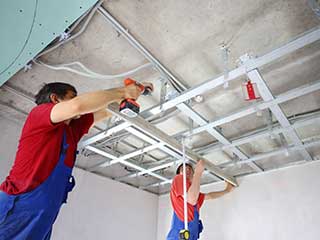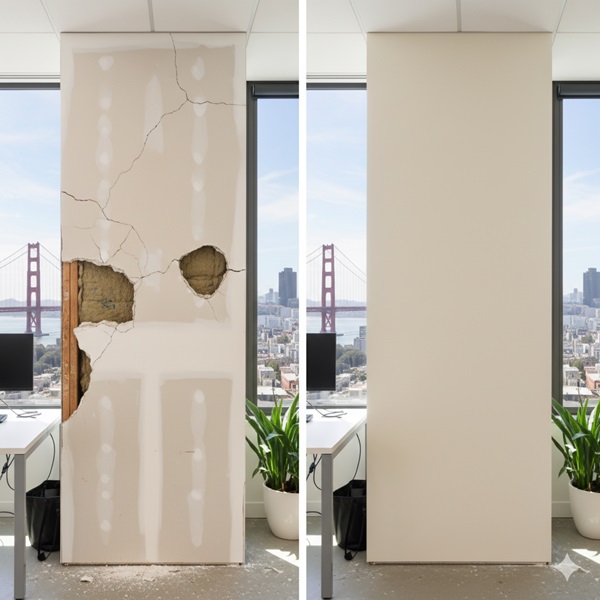Experience top-quality finishes from expert drywall contractors in combination with Interior Painting.
Step-by-Step Approaches to Achieving Flawless Drywall Repair Service and Installation
Accomplishing flawless drywall repair work and installment calls for a methodical technique. It entails comprehending the various sorts of drywall and the devices essential for the task. Proper area preparation is crucial prior to starting any work. Interior Painting. Each step, from covering openings to mounting new sheets, demands attention to detail. The process doesn't finish with installment; ending up methods are crucial for a refined look. The next steps will guarantee a smooth outcome, yet what specifically do they require?
Understanding Drywall Types and Tools Needed

The setup tools are similarly crucial. An utility blade is essential for cutting drywall sheets, while a drywall saw can aid in making exact cuts for components or electrical outlets. T-squares ensure precise dimensions, and drywall screws or nails safeguard the panels to wall studs. Additionally, a drywall lift can assist in the installment of huge sheets, reducing physical stress. Knowledge with these kinds and devices considerably adds to the performance and top quality of drywall tasks.
Preparing the Location for Repair or Installation
Preparing the area for drywall repair work or setup is crucial to ensure a reliable and smooth procedure. Initially, the surrounding room needs to be free from furnishings and various other challenges to supply adequate functioning area. This not only ensures security yet additionally stops damage to belongings. Next, it is important to cover the floor with decline cloths to catch any kind of particles or dirt produced during the job.
In addition, the wall surfaces ought to be inspected for any loosened paint or wallpaper that may hinder bond. Removing these components produces a tidy surface area for the new drywall. Prior to beginning, it is advisable to turn off power to electric outlets or fixtures around. Making certain sufficient lighting in the workspace will even more enhance exposure and focus during the repair or installation process. Interior Painting. By thoroughly preparing the area, one prepares for a successful drywall task
Step-by-Step Process for Patching Holes

Covering holes in drywall calls for an organized technique to assure a smooth repair. The initial step includes examining the size of the hole. For little holes, a patching substance might be sufficient, while bigger openings require a patch. Next, the broken location must be cleansed and prepared by eliminating any kind of loosened particles.
For little openings, applying spackling compound with a putty knife is recommended, smoothing it over the hole and feathering right here the edges. Once dry, sanding the area guarantees a smooth coating. For bigger openings, a drywall spot must be cut to size, positioned over the hole, and protected with screws. After setting up the patch, the same spackling process is duplicated, adhered to by fining sand.
Lastly, the patched area should be keyed and repainted to match the bordering wall surface. This thorough process ensures a professional look and prolongs the lifespan of the repair.
Installing New Drywall Sheets: A Comprehensive Overview
Setting up new drywall sheets requires mindful planning and implementation to ensure a visually appealing and tough surface. First, the location needs to be determined accurately to establish the number of sheets needed. It is vital to pick the ideal thickness, typically 1/2-inch for indoor walls and 5/8-inch for ceilings or fire-rated applications.
Next, the studs or framework must be inspected for any abnormalities, making certain they are straightened and effectively spaced. When positioning the drywall sheets, they need to be placed horizontally to minimize joints and improve architectural integrity. A drywall lift can be valuable for overhead installments.
Fastening the sheets with drywall screws at appropriate intervals makes particular a safe installation. It is essential to countersink the screws somewhat below the surface to prepare for the finishing process. Following these guidelines will certainly lead to a strong structure, all set for the following actions in drywall completing.
Finishing Touches: Insulation, Mudding, and Fining Sand Strategies
As soon as the drywall sheets are firmly fastened, the focus shifts to the finishing touches that will certainly give a sleek appearance. This process begins with taping, making use of either paper or fiberglass harmonize tape to cover the joints between sheets. The tape guarantees a smooth shift, minimizing the danger of splitting. Adhering to taping, mudding is crucial; a joint compound is applied over the tape to fill voids and produce a seamless surface. Usually, several layers are necessary, each one feathery out better than the previous to reduce presence.
After adequate drying time, fining sand is the final step in accomplishing a flawless finish. A fine-grit sandpaper is used to smooth the dried out compound, guaranteeing there are no bumps or imperfections. Focus to information during this stage is considerable, as it substantially affects the total appearance of the wall surface. Completion result must be an even, professional-looking surface area ready for priming and paint.
Regularly Asked Concerns
How Do I Pick the Right Drywall Density for My Project?
To pick the ideal drywall thickness, take into consideration the job's purpose, place, and structural needs. Standard densities consist of 1/2-inch for general usage and 5/8-inch for fire-rated applications, ensuring visit the site durability and compliance with building ordinance.

Can I Install Drywall Over Existing Drywall?
Yes, setting up drywall over existing drywall is feasible. It is crucial to assure the underlying surface area is totally free and secure from damages. Correct attachment and factor to consider of thickness are necessary for an effective installment.
What Are the most effective Practices for Drywall Disposal?
The best practices for drywall disposal include recycling when feasible, utilizing regional waste administration solutions, and complying with guidelines for harmful materials if appropriate. drywall contractor. Properly classifying and securing waste assurances conformity and safety during disposal
For how long Should I Await Mud to Dry Prior To Fining sand?
Commonly, one should wait 24-hour for drywall mud to dry before sanding. Nevertheless, drying time can differ based you can find out more upon humidity and temperature level, so looking for a company appearance is a good idea before continuing.
Exist Eco-Friendly Drywall Options Available?
Yes, eco-friendly drywall options are readily available. These options often use recycled products, low-VOC adhesives, and lasting production techniques, reducing environmental impact while providing effective insulation and longevity for numerous building and improvement projects.
An energy blade is vital for reducing drywall sheets, while a drywall saw can help in making exact cuts for electrical outlets or components. Preparing the area for drywall repair or setup is vital to ensure a effective and smooth procedure. Patching holes in drywall needs an organized approach to guarantee a seamless repair work. Setting up new drywall sheets needs cautious preparation and implementation to ensure a durable and aesthetically attractive finish. Yes, setting up drywall over existing drywall is feasible.